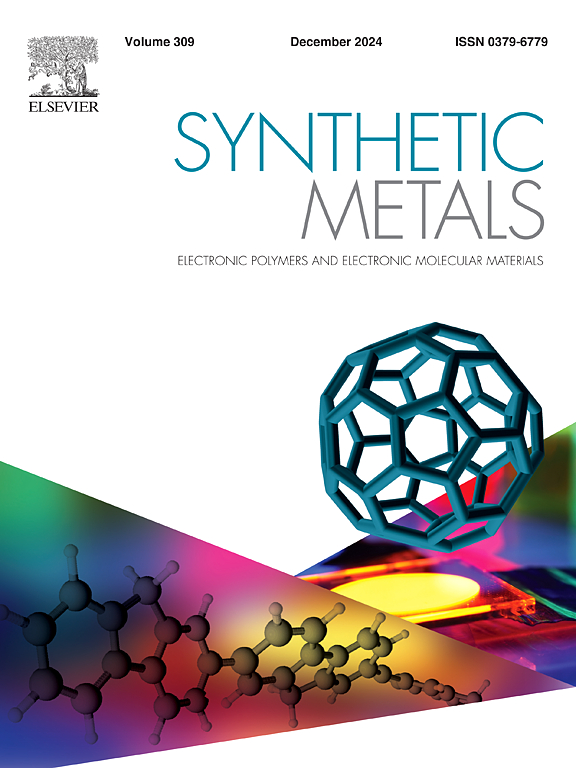对位氮杂喹啉二甲烷基醌类共聚物:构象平面性显著提高电化学性能和稳定性
IF 4
3区 材料科学
Q2 MATERIALS SCIENCE, MULTIDISCIPLINARY
引用次数: 0
摘要
本研究首次研究了基于新型诱人的醌单元对位氮杂喹啉二甲烷(p-AQM)的醌-供体(Q-D)交替共聚物的电化学特性。研究采用循环伏安法、电静态充放电循环法、电化学阻抗光谱法和光谱电化学法对四种聚合物(即 PAQM3T、PAQM4T、PAQM2T-TT 和 PAQM2T-TVT)进行了研究。众所周知,p-AQM 分子相对不稳定,但本文证明 Q-D 聚合物可以被可逆氧化,这表明 p 掺杂不会在烷氧基取代的 p-AQM 单元的亚甲基碳上产生高活性自由基。聚合物与小分子的这种独特行为可归因于共轭骨架上自由基的高效分散。不过,研究发现,电化学性能和稳定性在很大程度上取决于供体单元的性质。PAQM2T-TVT 因其骨架中存在平面噻吩-乙烯-噻吩(TVT)单元而具有更强的类醌特性,显示出最高的比电容值和等电容值(分别为 331 F/g 和 83 mF/cm2),并且在电静电循环中电容保持率更高,200 次循环后高达 92%。此外,PAQM2T-TVT 还由于具有更高的电子和离子导电性而显著提高了速率能力,可承受高达 10 mA/cm2 的电流密度。这项研究表明,单体单元的加入会增强聚合物骨架的构象平面性,这对于优化基于 p-AQM 的聚合物的电化学特性和循环能力至关重要,使它们成为包括(微型)超级电容器和电池在内的先进电化学应用的理想材料。本文章由计算机程序翻译,如有差异,请以英文原文为准。
Para-azaquinodimethane-based quinoidal copolymers: Significant enhancement of electrochemical performances and stability with conformational planarity
The electrochemical properties of quinoidal-donor (Q-D) alternating copolymers based on the new and attractive quinoidal unit para-azaquinodimethane (p-AQM) are investigated for the first time. A family of four polymers, namely PAQM3T, PAQM4T, PAQM2T-TT and PAQM2T-TVT, designed with different comonomers, is studied using cyclic voltammetry, galvanostatic charge/discharge cycling, electrochemical impedance spectroscopy and spectroelectrochemistry. While p-AQM molecules are known to be relatively unstable, it is demonstrated here that the Q-D polymers can be reversibly oxidized, indicating that p-doping does not generate highly reactive radical species on the methylene carbons of the alkoxy-substituted p-AQM units. This distinctive behavior of polymers vs small molecules can be attributed to a more efficient delocalization of radicals over the conjugated backbone. However, it is found that electrochemical performances and stability depend strongly on the nature of the donor unit. PAQM2T-TVT, having enhanced quinoidal character due to the presence of planar thiophene-vinylene-thiophene (TVT) units in its backbone, exhibits the highest specific and areal capacitance values (331 F/g and 83 mF/cm2, respectively) as well as improved capacitance retention upon galvanostatic cycling, up to 92 % after 200 cycles. Moreover, PAQM2T-TVT also shows remarkably improved rate capability, withstanding current densities as high as 10 mA/cm2, owing to higher electronic and ionic conductivity. This work suggests that the inclusion of monomer units inducing enhanced conformational planarity of the polymer backbone is crucial in optimizing the electrochemical properties and cyclability of p-AQM based polymers, making them promising materials for advanced electrochemical applications including (micro)supercapacitors and batteries.
求助全文
通过发布文献求助,成功后即可免费获取论文全文。
去求助
来源期刊

Synthetic Metals
工程技术-材料科学:综合
CiteScore
8.30
自引率
4.50%
发文量
189
审稿时长
33 days
期刊介绍:
This journal is an international medium for the rapid publication of original research papers, short communications and subject reviews dealing with research on and applications of electronic polymers and electronic molecular materials including novel carbon architectures. These functional materials have the properties of metals, semiconductors or magnets and are distinguishable from elemental and alloy/binary metals, semiconductors and magnets.
 求助内容:
求助内容: 应助结果提醒方式:
应助结果提醒方式:


